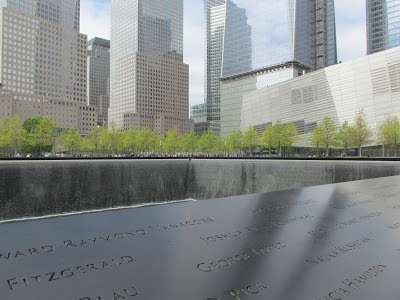
In order to see the 9/11 Memorial in lower Manhattan you must first remove your belt and anything metal, pass through airport-level security, and show your ticket at six separate check points. After making it past all this on
a sunny afternoon I did not feel especially free by the time I entered the site.
Still, the Memorial can provoke powerful emotions that tend to eclipse
the oppressive experience of being processed, prodded and examined before acceptance.
Standing in the wide court surrounding the two pools, built on the same spots
where the Twin Towers stood, you cannot help sensing what is missing. Still water circulates
below the names of victims, each die-cut into bronze, and then descends the thirty-foot
waterfall into a void.
The guide touts it as the largest water cascade in North
America.
People stroll slowly
around the large square pools, often stopping when they find a familiar name or
group of first responders. School classes search for people on electronic
directories. Others sit on stone benches to reflect. Eventually the site will
include a museum, set to open this fall, office and retail space, and more than
400 newly planted trees.
You get a sense that if someone spoke too loudly or uttered any “inappropriate”
thought it would take only seconds before an armed team descended and removed
them. It’s certainly possible that someone might want to attack such a
monument. But doesn’t the same go for many other sites?
Like Bloomberg, Memorial and Museum President Joe Daniels calls it a reminder – of “what we have endured” and “our ability to come
together in the wake of tragedy.” That is clearly true. But visiting also points
to some of what has been lost or surrendered since the attacks more than a decade ago. Daniels adds that the recent official opening marked “a new chapter in the history
of New York City and the United States.”
At this point it’s still hard to tell
how the chapter will end.



































No comments:
Post a Comment